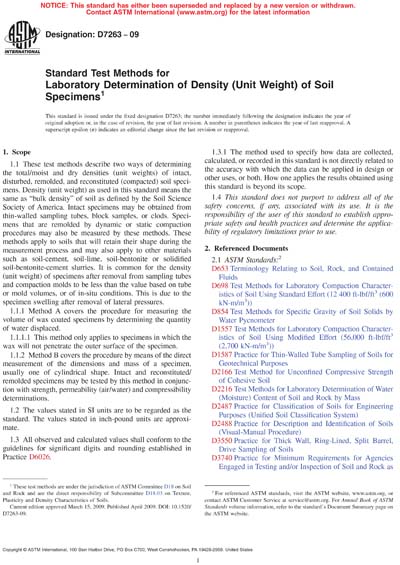Historical
ASTM D7263-09
Standard Test Methods for Laboratory Determination of Density (Unit Weight) of Soil Specimens
1.1 These test methods describe two ways of determining the total/moist and dry densities (unit weights) of intact, disturbed, remolded, and reconstituted (compacted) soil specimens. Density (unit weight) as used in this standard means the same as “bulk density” of soil as defined by the Soil Science Society of America. Intact specimens may be obtained from thin-walled sampling tubes, block samples, or clods. Specimens that are remolded by dynamic or static compaction procedures may also be measured by these methods. These methods apply to soils that will retain their shape during the measurement process and may also apply to other materials such as soil-cement, soil-lime, soil-bentonite or solidified soil-bentonite-cement slurries. It is common for the density (unit weight) of specimens after removal from sampling tubes and compaction molds to be less than the value based on tube or mold volumes, or of in-situ conditions. This is due to the specimen swelling after removal of lateral pressures.
1.1.1 Method A covers the procedure for measuring the volume of wax coated specimens by determining the quantity of water displaced.
1.1.1.1 This method only applies to specimens in which the wax will not penetrate the outer surface of the specimen.
1.1.2 Method B covers the procedure by means of the direct measurement of the dimensions and mass of a specimen, usually one of cylindrical shape. Intact and reconstituted/remolded specimens may be tested by this method in conjunction with strength, permeability (air/water) and compressibility determinations.
1.2 The values stated in SI units are to be regarded as the standard. The values stated in inch-pound units are approximate.
1.3 All observed and calculated values shall conform to the guidelines for significant digits and rounding established in Practice D 6026
1.3.1 The method used to specify how data are collected, calculated, or recorded in this standard is not directly related to the accuracy with which the data can be applied in design or other uses, or both. How one applies the results obtained using this standard is beyond its scope.
1.4 This standard does not purport to address all of the safety concerns, if any, associated with its use. It is the responsibility of the user of this standard to establish appropriate safety and health practices and determine the applicability of regulatory limitations prior to use.
Content Provider
ASTM International [astm]






